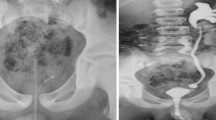Abstract
Purpose. To determine (1) the reasons for the frequently long delay in the diagnosis of an infrasphincteric ectopic ureter in girls, and (2) what role the radiologist can play in decreasing the delay. Materials and methods. Twelve girls were referred to our hospital from June 1994 until April 1997 for evaluation of constant urinary dribbling and/or vaginal discharge. Available imaging studies, radiology reports, and clinic notes were reviewed. Results. Mean age at the time of diagnosis was 6 years 7 months (range 2 years 10 months to 11 years 11 months). Mean delay until diagnosis after presentation was 2 years 5 months. Excluding the one girl whose ectopic ureter was diagnosed while she was still in diapers, mean age at the time of the first parental “complaint” was 4 years 9 months. The significance of the classic history of constant urinary dribbling was not recognized by physicians in 7 girls for 4 months to 7 years 10 months after presentation. Physical exam was not meticulously performed, as the ectopic orifice was visible in 8 of 12 girls. Imaging studies were ineffectively utilized: no imaging was done (for 2 years in 2 girls), inappropriate studies were done (ultrasound and voiding cystourethrography) and were misleading, studies were called normal when they were not (ultrasound and excretory urography), or perinatal imaging led to the incorrect assumption of a congenitally absent kidney in one girl and a multicystic dysplastic kidney in another. Excretory urography (EU) was diagnostic in all 10 girls with a duplex kidney, and computed tomography (CT) was supportive in 2 with a dysplastic kidney. CT was an adjunct in 3 girls; a Tc-99m-dimercaptosuccinic acid (DMSA) scan was needed in 2. Conclusion. The classic history of constant urinary dribbling in a successfully toilet-trained girl should immediately lead to an imaging search for the portion of kidney (or entire kidney) drained by an infrasphincteric ectopic ureter. EU should usually be the first imaging performed and is often the only imaging study needed.
Similar content being viewed by others
Author information
Authors and Affiliations
Additional information
Received: 14 January 1998 Accepted: 8 June 1998
Rights and permissions
About this article
Cite this article
Carrico, C., Lebowitz, R. Incontinence due to an infrasphincteric ectopic ureter: why the delay in diagnosis and what the radiologist can do about it. Pediatric Radiology 28, 942–949 (1998). https://doi.org/10.1007/s002470050506
Issue Date:
DOI: https://doi.org/10.1007/s002470050506




